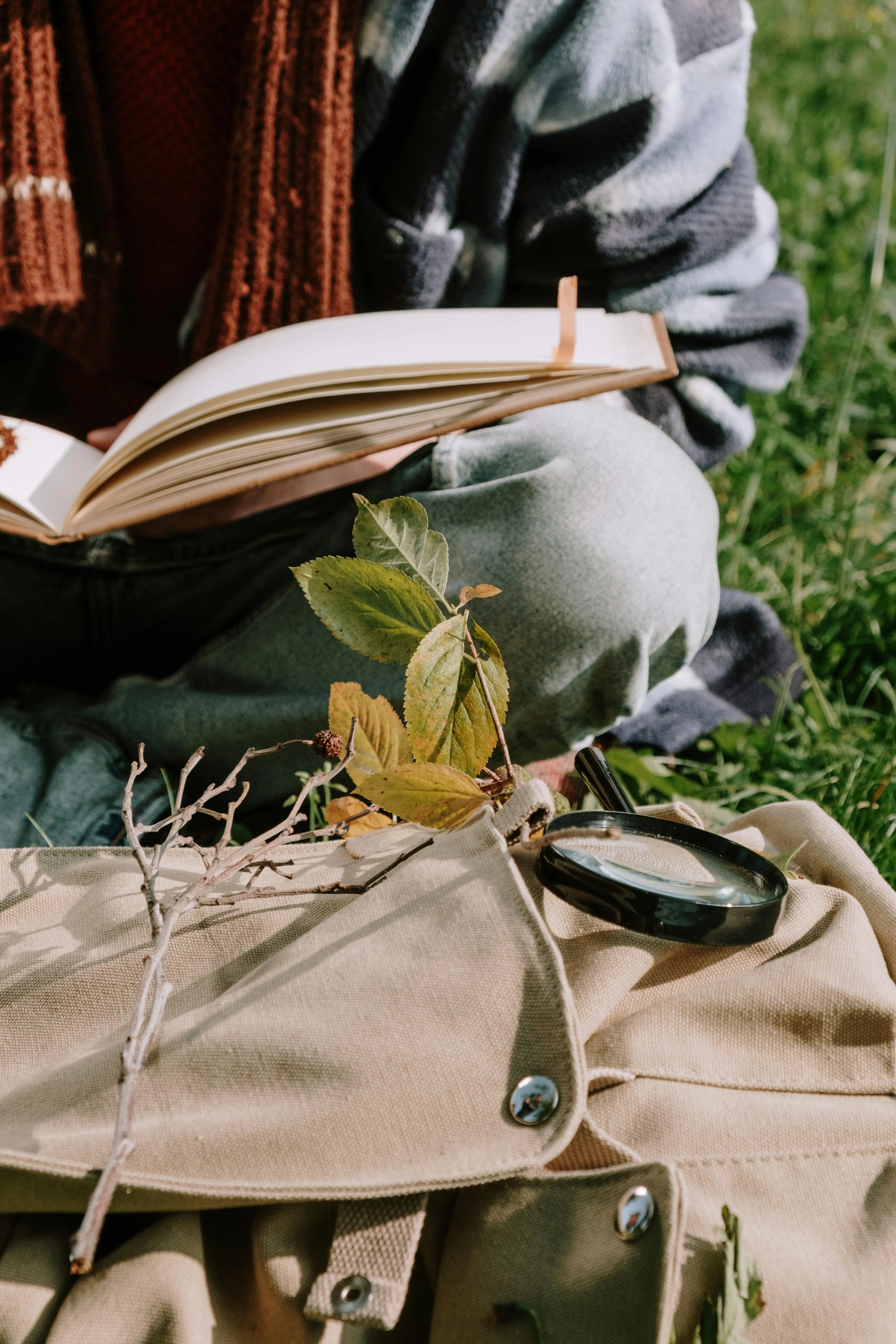
Be a Land Steward.
Sign up for Greenhouse Gases -
a weekly-ish newsletter that will teach you the science behind regenerative gardening, with action steps to help you make a difference in your backyard.

Sign up for Greenhouse Gases -
a weekly-ish newsletter that will teach you the science behind regenerative gardening, with action steps to help you make a difference in your backyard.

I have studied herbalism for 24 years, and am currently working towards completing my second community herbalist program. My herb garden is a tranquil and fragrant place that brings me joy. To garden with herbs opens up a whole world of flavor, visual beauty, and self-sufficiency.
I enjoy my herb garden not only for making herbal remedies, but also for herbs that I can dry and use in cooking throughout the year.
Since I make my own tea and herbal seasonings, I’m able to save money at the grocery store. I’m also able to grow herbs that are difficult to find in stores or even online, such as catmint, self heal, or centaury.
Another benefit that I receive from herbs is how they add visual beauty to the garden. Their flowers and scents bring in a wide variety of bees, butterflies, and other beneficial insects.
Herb gardens are a great way to add regenerative features into your existing garden. Many herbs are perennials, so they have a greater carbon sequestration potential than annual plants. Herbs also reduce the need for pesticides in the garden, and support organic practices.
We’ll dive into all of the environmental benefits of an herb garden in this article, along with a variety of ideas for your herb garden goals.
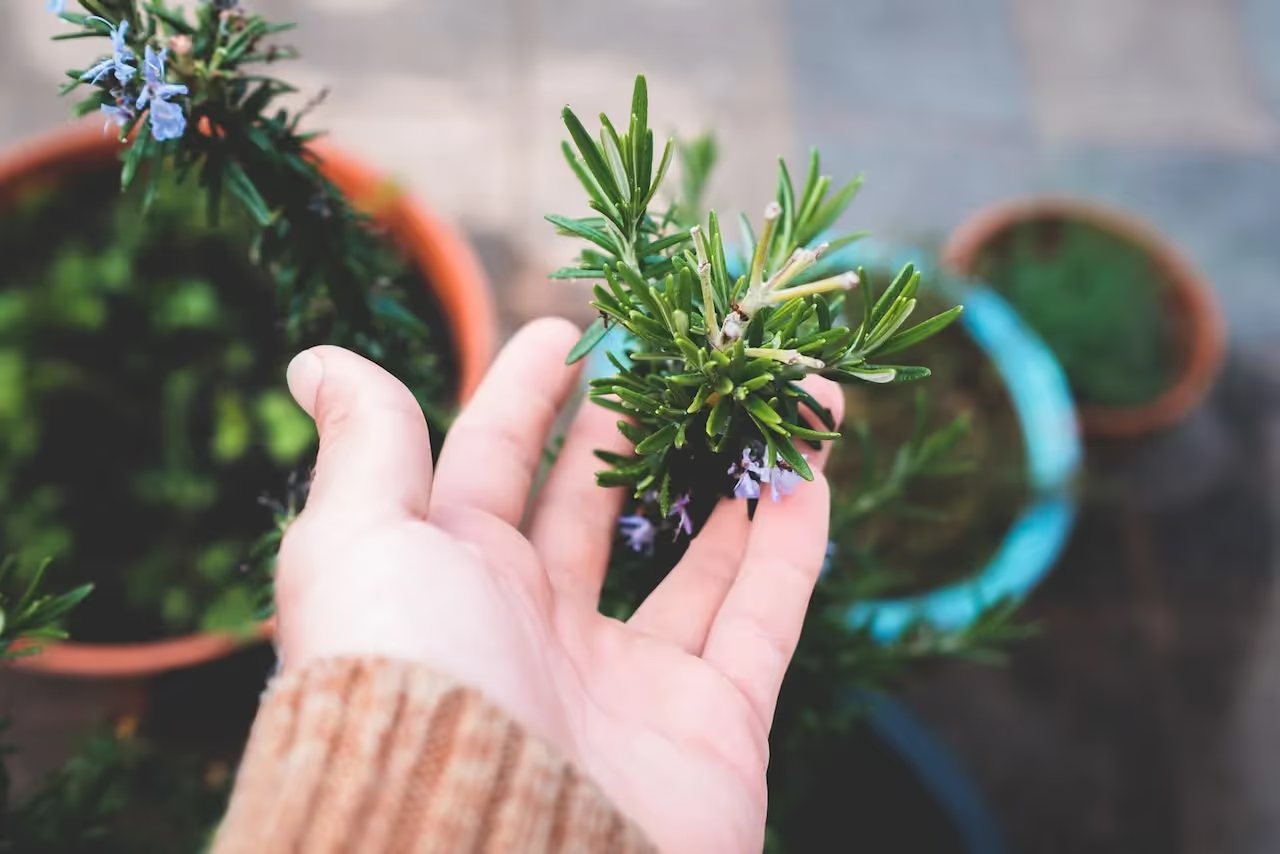
There are many reasons to grow an herbal garden, and your goals will dictate what plants you decide to grow.
For example, a kitchen herbal garden will have different herbs in it when compared with tea garden or medicinal herbal garden.
Of course, you can always mix and match plants, depending on what you like and what you know you’ll enjoy working with. There’s no reason not to plant culinary basil next to medicinal calendula, for example.
Here’s what to do before you start your herb planting.
If you’re someone who likes to cook, make a list of all of the herbs and spices that you cook with on a regular basis. Also, think about herbs and spices that you would like to have in your kitchen, but don’t due to cost.
If you’re someone who likes to drink herbal tea, make a list of the varieties that you enjoy the most and the ingredients in them.
If you’re an herbalist, look in your medicine cabinet and make a list of the ingredients in your store-bought tinctures, salves, and teas. Also add hard to find herbs to your list that you’ve been wanting to work with or are often out of stock.
If you’re stuck, reference our herbal reference list here, or our garden layout ideas below for some inspiration!
sources: herbalgram | bee gardening and beneficial insects | cold stratification list | science direct | clemson | washington college | attracting beneficial insects, clemson | university california | north carolina state university | university minnesota extension
Do you have a balcony where you can grow plants vertically and in pots, or a 4x12 foot raised bed in the garden? Maybe you have a large space that is a blank slate.
Either way, this will tell you how many herbs you will be able to realistically plant.
If you have a container garden, you may wish to plant one herb per container, so that you can get a significant harvest from each plant.
In a 4x12 foot raised bed, you may wish to plant 4-12 herbs, depending on the yield that you want to get from each.
If you have a larger space to work with, then you might not need to limit yourself in terms of how many herb varieties you can plant. You may want to make an herb spiral, or plant herbal guilds around larger plants like hawthorn trees or camellia sinensis sinensis (green tea).
Now that you’ve calculated how many herbs you can plant, look at your list and narrow down the plants that you’d utilize and benefit from the most.
Take your growing zone into consideration. While most herbs are able to grow in zones 3 and above, some plants will only yield a harvest in warmer growing zones. For example, passionflower does well in zones 7 and above.
Decide how you want to get your plants.
For most folks, the options would be to start your herbs from seed or to purchase starts at a plant nursery. You’d want to buy seeds at the end of the year into January, or purchase starts in spring.
If you happen to know someone who is a gardener and has a lot of herbal plants, you may be able to ask them for cuttings or divisions of plants that you can then transplant into your garden. Since many herbs are quite vigorous, most gardeners won’t mind sharing with you.
My favorite herbal seed and seedling stores:
Seeds:
Strictly Medicinals, Oregon: They have almost every herb seed you could ever want to grow, and they also sell starts. This company is owned by renown herbalist Richo Chech, and is USDA organic certified.
Swallowtail Garden Seeds, California: They offer a wide range of herb and flower seeds, with some really hard to find varieties in their collection.
Seedlings:
Planting Justice, California I have been happy with all of my seedling orders from planting justice. They focus on perennial plants, and everything they grow is organic.
Crimson Sage, California: An organic herb seedling farm with a large selection of herbal medicine. Some plants are toxic if not prepared properly, please do your research before planting.
In-ground:
If you are starting a brand new in-ground herb garden:
If you are planting herbs in an existing in-ground garden
Raised Bed:
Containers:

Starting herbs from seed indoors:
-> December-April
Gardening with herbs is a great practice for any gardeners who are bored during the wintertime, as you can start some herb seeds indoors as early as December!
Technically, you’re not planting herbs so that they will start growing in December. Instead, you’re starting the process of cold stratification with select herb seeds to ensure successful germination in late winter-early spring.
In our herb chart in this article, we note if each herb seed needs cold stratification and if it needs light to germinate.
We also have this in-depth cold stratification guide to help you if this is your first time with the process.
However, don’t let this deter you from starting herbs from seed!
Many herbs don’t need the cold stratification process, such as basil, chamomile, caraway, fennel, or calendula, just to name a few.
As a rule of thumb, annuals usually don’t need to be cold stratified and have faster germination times, so they can be sown indoors as early as 4 weeks before your last frost. You would start them in seed starting trays or soil blocks, and place them under a grow light.
After last frost, you can also direct sow your annuals outdoors. I recommend this for any herb that you want to harvest in quantity. For example, I always direct sow my chamomile seeds because I want to be able to harvest a year’s worth of chamomile tea. It would take up a lot of space in my seed starting shelf if I were to start each chamomile plant from seed indoors!
Planting herb starts outdoors:
-> April-May, or after last frost
If you have purchased herb starts, you can plant them outside after your last frost. Mulch around your herb starts to keep them warm early in the season.

Many green leafy herbs and flowering herbs are cut and come again, meaning that you can get multiple harvests from them.
For example, if you harvest the top leaves off a basil plant, but leave the bottom leaves in tact, it will continue to grow. In another couple of weeks, you can harvest from it again.
Flowering herbs, like calendula, are essentially being “deadheaded” when you harvest them. Deadheading is the process of pinching off flowers to encourage a plant to put on more flowers. You may do this with ornamentals to keep these plants looking fresh, but with herbs you also get the benefit of multiple harvests.
If they are perennials, some herbs can bounce back from vigorous cuttings. I can cut my nettles, mint, catnip, catmint, oregano, and mugwort almost to the ground three-four times a growing season.
Dreaming of a garden of herbs, but not sure where to start?
I’ve got you covered: check out these herbal garden layouts for different goals and locations. From balconies to raised beds to shady woodland edges, you’re sure to find some herb garden ideas and inspiration here.
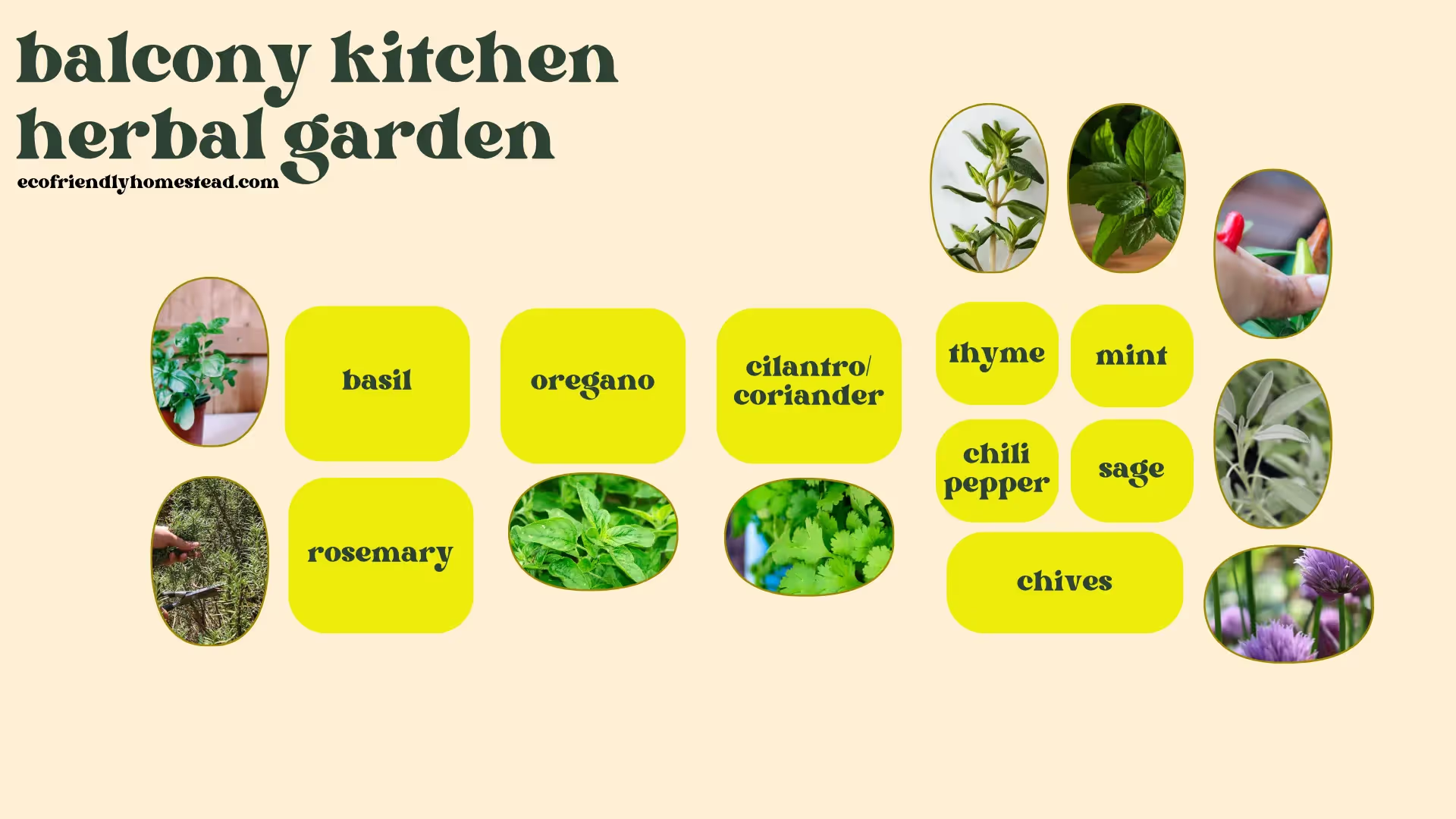
This herbal container garden is designed to fit on a balcony, but of course you can also adapt it to fit on a deck, patio, or small yard.
All of the herbs offer beauty and fragrance outside, and lots of flavor in the kitchen. Aside from basil and cilantro, all of the herbs are perennial and will become more robust year after year.
If you experience hot summers, your basil and cilantro will go to seed. Save the basil seed to plant next year, and use the cilantro seed - coriander - in the kitchen.
If you find yourself with an abundance of basil, rosemary, oregano, thyme, mint, or sage, these herbs can be hung to dry. Once dried, crumble the herb leaves into glass jars to add to your cooking throughout the rest of the year.

*NOTE: Comfrey should not be taken internally and should only be applied topically. You can also mulch with the abundance of leaves that comfrey provides!
This bee gardening herbal layout offers something for the pollinators and beneficial insects. But you also get to enjoy the harvest and beautiful flowers as well!
The herbs here will provide a food source for bees from early spring with borage to early fall with goldenrod.
If you’re in zone 6 or above, your fennel will likely perennialize. Dry out the seeds to use in cooking, and cut back the stalks to the base of the plant. It will grow back with vigor next spring.
Lavender, goldenrod, comfrey, echinacea, and catmint are perennials, so you and the bees will get to enjoy these herbs for many seasons.
Sometimes echinacea won’t flower its first year, but you should get blooms on year two.
Borage and calendula are annuals, but they will readily self-sow.
All of this means that you just need to plant this garden once to enjoy years of blooms, herbal harvests, and bee spotting!
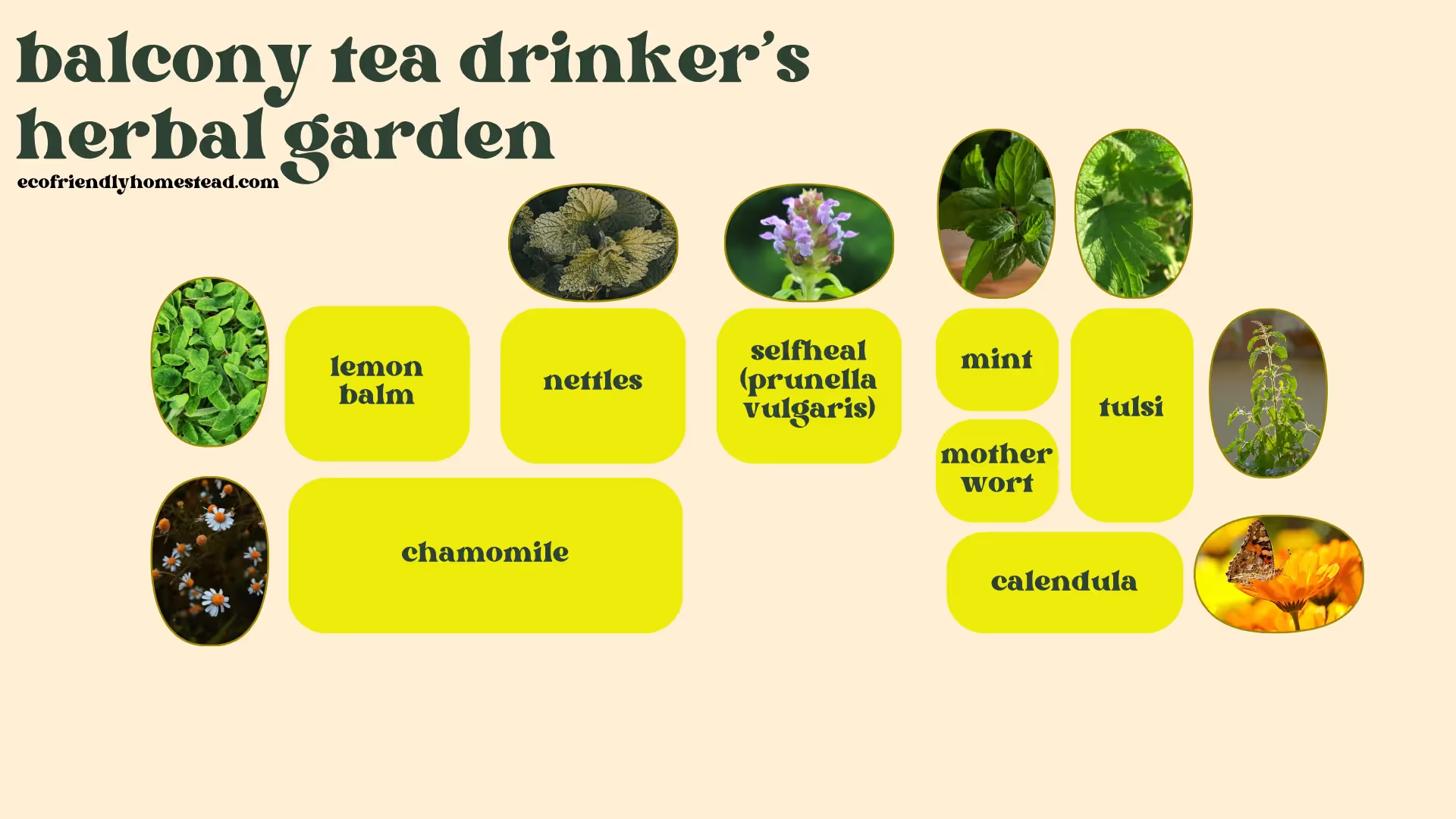
*NOTE: Don’t harvest nettles for consumption after they go to seed, as at that point in their life cycle they contain a high amount of oxalates and can cause health issues. Also, nettles sting when they are fresh, so wear protective gloves when you harvest them.
This container garden is designed to fit on a balcony, but of course you can also adapt it to fit on a deck, patio, or small yard.
These medicinal herbs can be dried, stored in jars, and then made into tea.
The only annuals here are chamomile, tulsi, and calendula. Calendula is a hardy annual and will self-sow, so you’ll likely find this flower growing in your container next year.
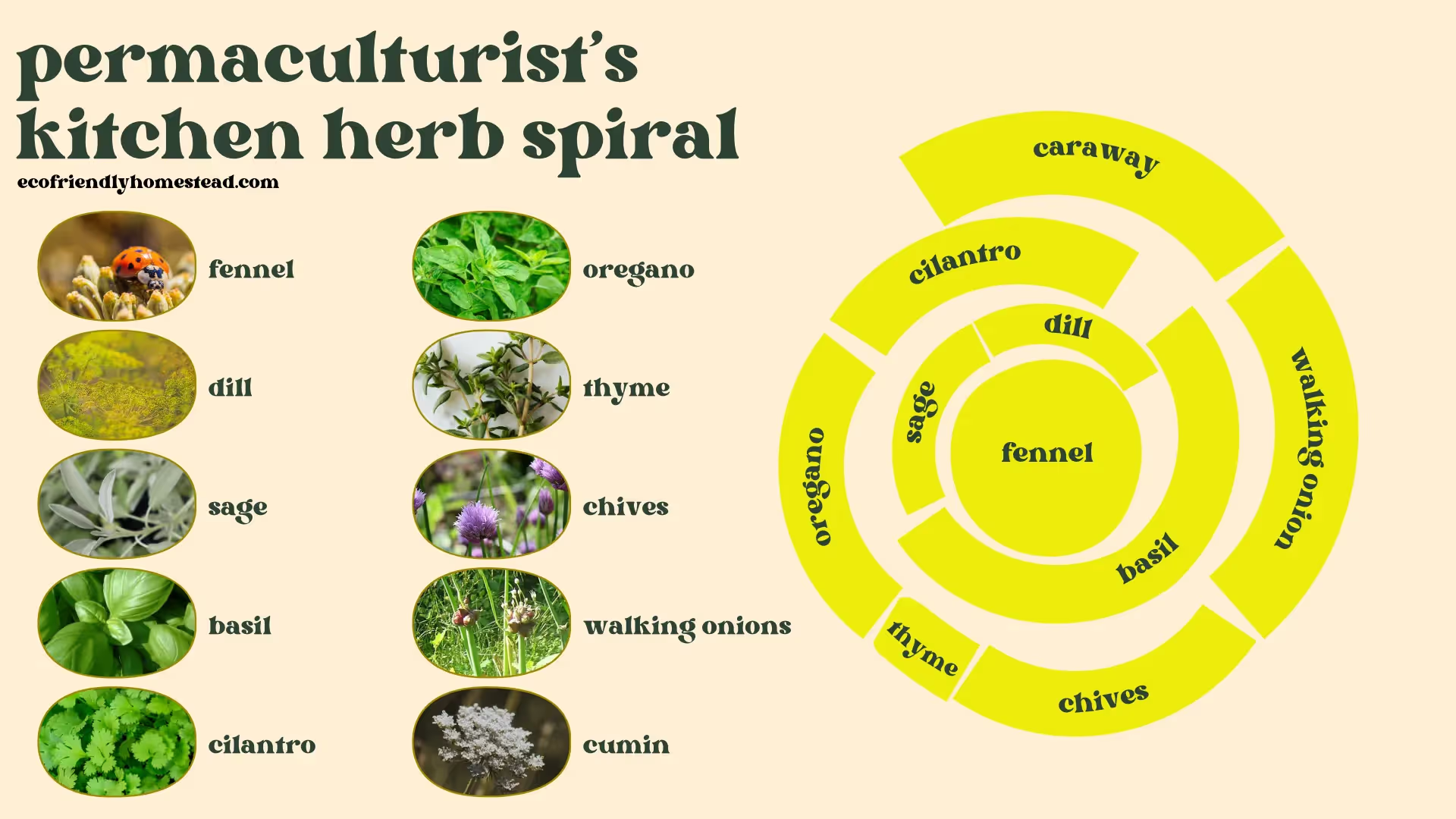
Herb spirals are a popular feature of a permaculture garden and are often created close to the house. In this way, it’s easy to go out and harvest fresh herbs to add to meals in the kitchen.
In this herb spiral layout, fennel and dill provide a towering center point that the other herbs gather around to create a beautiful display. I always need more basil, so I gave this herb an extra large section of the spiral. Chives and Egyptian Walking Onions offer frequent harvests, so I placed them at the outer edge for easy access.
Let your cilantro go to seed to get coriander, and in your second year your chives will bloom for a tasty second harvest. You’ll likely need to wait for year two for the caraway harvest, but the tasty seeds are worth it!
Your fennel and dill will likely become perennial if you’re in zone 6 or above. Other perennials are Egyptian walking onion, chives, thyme, oregano, and sage.
If you find yourself with excess fresh herbs, hang them inside to dry. Then, crush the leaves into glass jars to add to your meals throughout the winter and early spring.
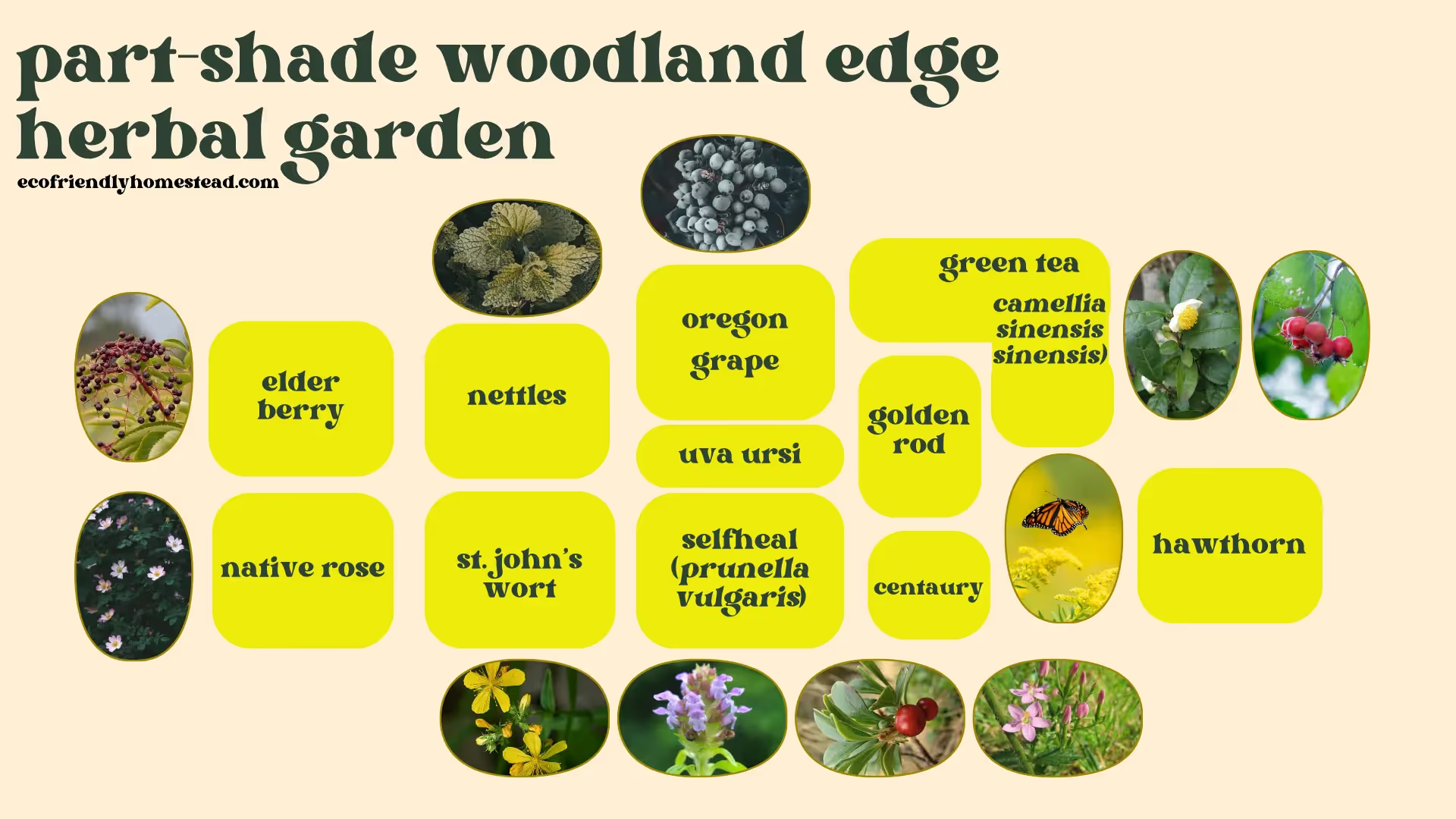
*NOTE: Don’t harvest nettles after they go to seed, as at that point in their life cycle they contain a high amount of oxalates and can cause health issues. Also, nettles sting when they are fresh, so wear protective gloves when you harvest them.
Don’t let a shady or wooded backyard deter you from planting an herb garden! In fact, some herb plants need part shade and slightly acidic soil in order to thrive. You can still plant an herb garden in a woodland landscape.
This herb garden is designed so that the top part of the graphic is closest to the shade or woodland edge. The Oregon grape is deeper into the woods because it thrives in more shade, whereas native rose, St. John’s Wort, selfheal, centaury, and hawthorn enjoy some sunshine.
If you’re nervous that the nettles will take over your wooded area, opt for adding in more uva ursi or a second elderberry tree instead.
Elderberry, rose, green tea, and hawthorn will take a few years to get established, but they are so worth the wait!
Everything in this garden is a perennial so you will only need to plant this garden once and can harvest from your shade-loving herbal garden year after year.

*NOTE: Comfrey should not be taken internally and should only be applied topically. You can also mulch with the abundance of leaves that comfrey provides!
Grow medicinal herbs in guilds to help each part of the equation to thrive.
In this guild, elderberry takes center stage.
Dog rose brings some protection to the elderberry from deer. Thyme works as a ground cover to help prevent weeds. Comfrey and mullein offer lots of leafy organic matter for mulching around the other plants. Calendula will add beauty with flowers from late spring through first frost. Astragalus is a nitrogen fixer, so when it is cut back it can provide a nitrogen boost to the surrounding plants.
Every plant aside from calendula is a perennial in this guild. However, the calendula will self-sow and come back continually.
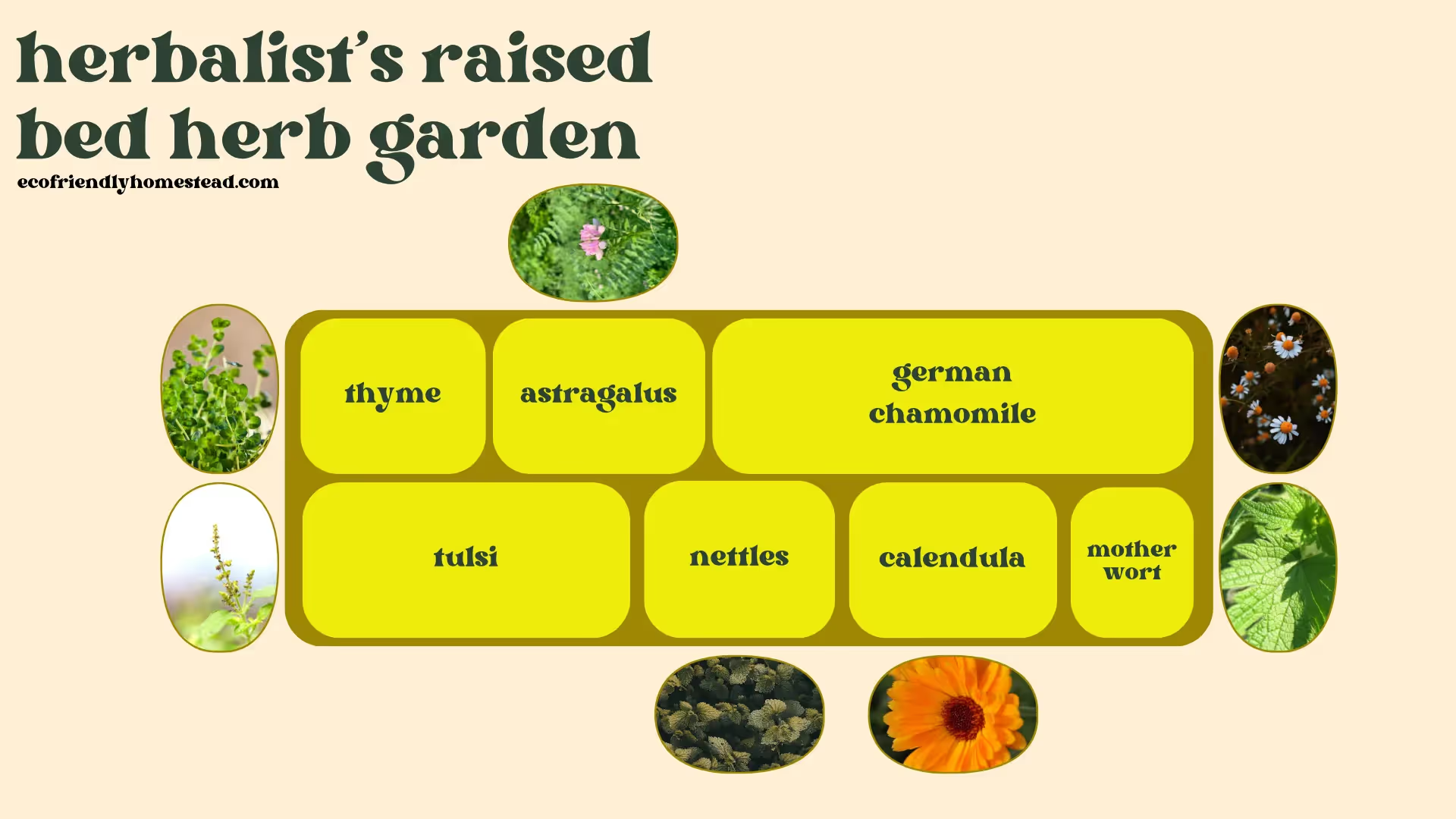
*NOTE: Don’t consume nettles after they go to seed, as at that point in their life cycle they contain a high amount of oxalates and can cause health issues. Also, nettles sting when they are fresh, so wear protective gloves when you harvest them.
Grow medicinal herbs in a raised bed to enjoy as teas and tinctures year-round.
In this raised bed herb garden, Tulsi and chamomile are the only annuals that will need to be re-sown. The calendula will self sow itself and persist year after year.
Harvest the nettles continually until they go to seed to prevent them from spreading too much. If you have more than you need, you can mulch with the nettles or add them to your compost for a great nitrogen boost.
The height of motherwort, especially after its first year, will add some visual interest to the garden as well.
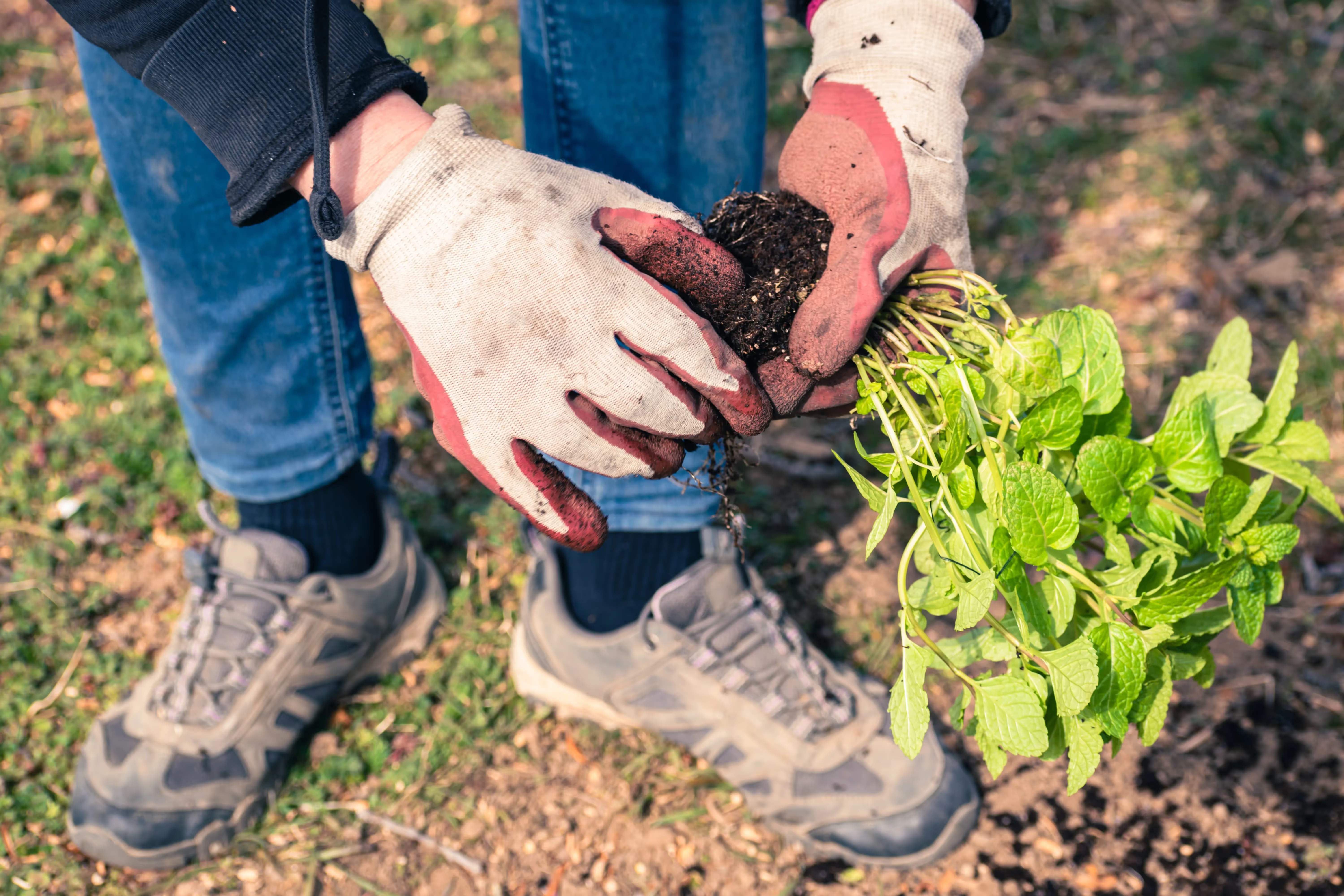
Some plants like nettles and mint are great companion plants for vegetables, but are so vigorous that you will likely want to plant them in a container nearby.
Other plants, such as chives, may deter pests with their onion-like scent. Many herbs attract beneficial insects that help with pest control in the garden. See our full article on attracting beneficial insects with herbs here.
Entice bees and other pollinators into the garden with showy and fragrant herbal flowers, and they’ll stay a while to pollinate your vegetable plants too.
Grow winter rye or alfalfa in the late fall to nourish the soil after annual herb plantings.
Learn more about cover crops in our full guide here.
Add mulch around your herbs to protect them from temperature extremes and help with water retention. I recommend organic straw, grass clippings, and autumn leaves for mulch around herbs.
Mulch also increases soil organic matter levels, and can help balance out the structure of both clay and sandy soils.
No-till practices preserve soil structure, moisture, and microbial activity. This can enhance herbal root development, nutrient uptake, and water retention. All together, the yield and health of your herbs are improved.
When soil is tilled, it releases carbon back into the atmosphere. As regenerative gardeners, we want to avoid this as much as possible.
There is an alternative to tillage. In compacted soil, use a broadfork to loosen the soil. This has worked great for my garden in the past.
Most herbs, especially perennials, don’t need as much water as other crops such as brassicas.
This means less work for you, and less of a strain on your water bill, well, or water storage system.
Regenerative gardening focuses on healthy soil, healthy food, and a healthy planet. This means no synthetic pesticides or herbicides. Synthetic inputs create soil that is void of the normal microbe-plant relationships. These chemicals are also made from petroleum products. Overall, synthetic inputs add greenhouse gases into the environment.
I definitely recommend that you seek out diversity in the herbs that you plant. Source your herb starts from local growers if possible, or look for interesting varieties that have cultural significance to you or are native to your region.
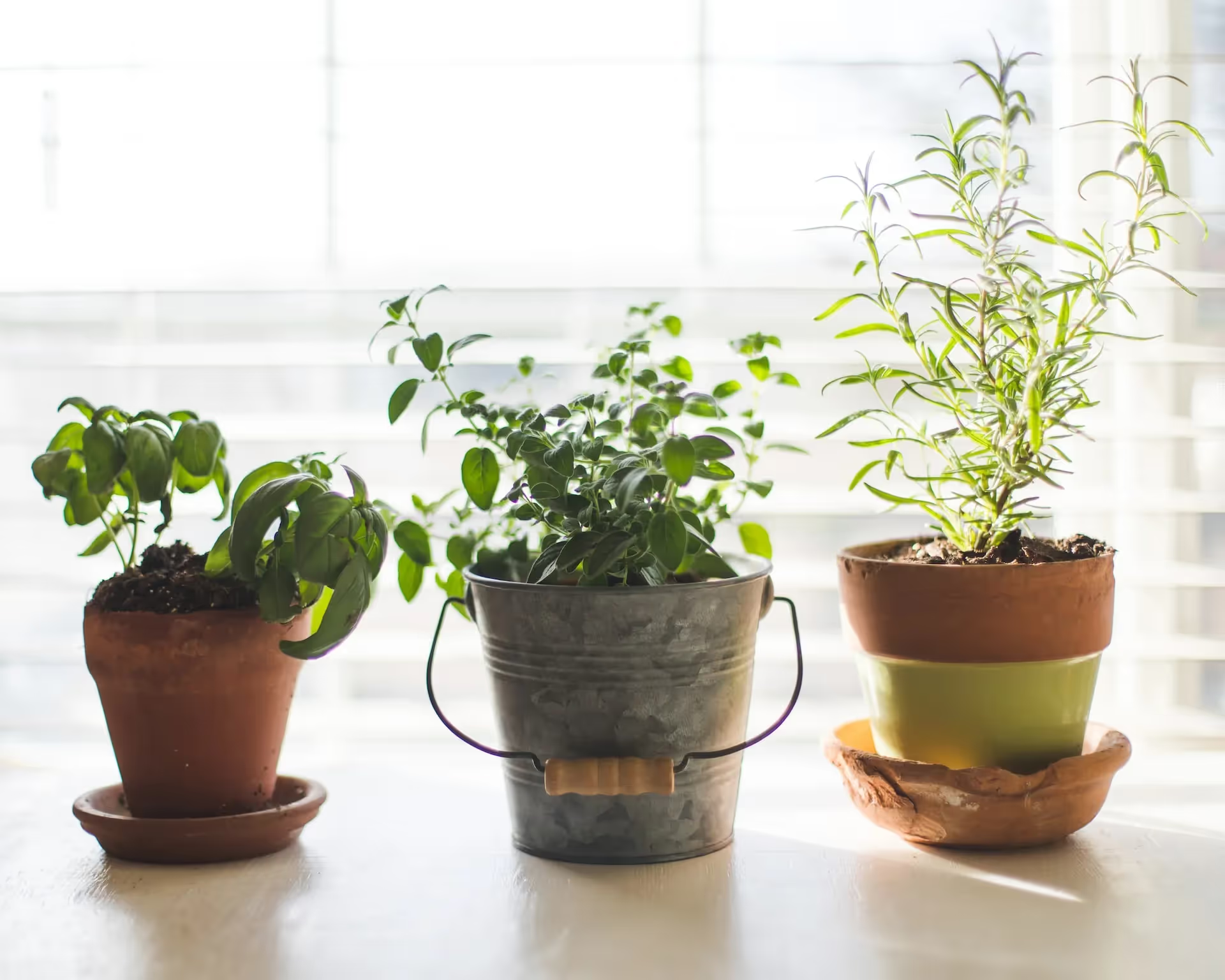
Overwatering:
Avoid overwatering or waterlogged conditions that can lead to rot. I’ve found that mediterranean perennials, such as lavender and rosemary, especially need to avoid waterlogged soil in order to thrive.
Spreading perennials:
Certain perennials have a tendency to spread in the garden, and can take over your soil if you do not harvest from them regularly and tend to them.
You can see this as a good thing, since you will receive many harvests from a single planting.
However, you can prevent any issues if you plant your prolific herbs in containers.
Herbs that benefit from containers are:
Self-sowing herbs:
Certain herbs really only need one single sowing, because they are very good at self-sowing after that and you’ll never need to plant them again.
This can be a good thing or a bad thing, depending on your garden and how much space you have.
Be vigilant about volunteer plants in the garden if you’d like to avoid this. Cut plants back before they go to seed, or stay on top of harvesting flowers/seeds to prevent their spread.
Prolific self-sowers are:
The herbs in my garden provide so many benefits for me, and become focal points with their height, interesting flowers, and the sound of bees happily finding nectar and pollen on them.
I also love how herbs have helped me to become more self sufficient. As someone who enjoys cooking, it's so helpful to have my own herbs on hand to add to meals. Since I'm able to grow most of my own medicinal tea supply, I save a lot of money on herbs that I'd otherwise have to buy.
I hope that this article has helped you to get excited about your herb garden, and has offered you some ideas for how to get started.
Here are some other articles that will help you understand gardening with herbs more:
Bee gardening to attract pollinators and other beneficial insects
54 plants for regenerative gardens